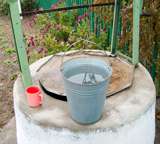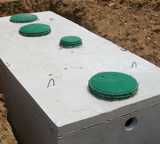Inspection Services
Well & Septic Evaluations to cover all of your Wisconsin inspection needs.
Well Inspection & Water Testing

Properly constructed and maintained water wells can provide many years of trouble-free service, but wells can eventually deteriorate or become damaged and allow surface contaminants to enter the water. In addition, some groundwater can contain one or more chemical substances in levels above health-based standards. In some cases, contamination of the water can be detected by sight, taste or smell; however, many of the most serious problems can only be detected through laboratory testing of the water. Public water systems are tested regularly for a variety of contaminants. However, if you have a private well, regular testing is your responsibility. Well construction inspection and improvements, are important steps in keeping your well water safe.
Water that has become contaminated by human or animal waste can transmit a variety of infectious diseases, including dysentery, salmonellosis, hepatitis, and giardiasis. Symptoms vary, but nausea, vomiting, and diarrhea, with or without fever, are most common. These bacteria do not usually cause disease themselves, but their presence indicates that surface contamination has found its way into the well and disease organisms may also be present.
In Wisconsin, it is required for Property Transfer Inspections to test for Bacteria, Nitrates and Arsenic. Depending on if it is an area where corn has been grown consistently then Atrazine should be considered.
Here is a great site with information about Wisconsin Well Water: http://dnr.wi.gov/topic/wells/.
Septic Testing & Evaluation

Septic systems come in various types of designs. The purpose is to recycle waste water without contaminating our water reserves or environment.
Once you have the basic concept of a septic system, it does not matter what system is used the end result is always the same. Waste is broken down so that the environment and the water table are not contaminated. There is certain criteria that needs to be met to do this though. Because of this criteria, various types of systems may need to be installed.
Locations for the installation of the septic system will have varying soil types at various soil depths. Some soils are better suited to drainage than other soils that may hinder drainage. Some soils are shallow to bedrock as well and could allow non-treated waste-water to seep down cracks in rock strata to the water table below.
Depending on the type of system to be used there needs to be at least 36" of proper drainage soil below what is called the infiltrative surface. This means below the drainage pipe and material used such as gravel that is in the drain field area.
A soil evaluation will be performed before installing a new system by a certified soil tester to determine the soils ability to properly drain. This will indicate the type of system that will be allowed to be used. A conventional system is the least expensive, with the At-Grade next and the Mound after more costly after that. All these other systems are doing is artificially lifting the drain fields higher to meet the 36" rule.
Septic tanks do what is called anaerobic treatment, or without oxygen, plus settles out sludge to prevent it from reaching the drainage field area. It is called aerobic treatment when oxygen reaches the effluent liquid to oxidize it. The soil then filters the remaining contaminants out.
Typically septic tanks should be pumped every three years or checked as they may not be in need of pumping( I also do these checks) if not used regularly. Septic evaluations go through various components of the system to determine any visual evidence of defects.
I highly recommend the Client be present on these evaluations for educational and for future maintenance purposes.
Questions and Answers about Well and Septic Evaluations,
What is a well inspection in Wisconsin?
A well inspection evaluates the condition, compliance, and functionality of a private well and its pressure system. It is typically conducted by a licensed well driller or pump installer, as required by Wisconsin law since June 1, 2008. The inspection ensures the well meets state regulations and provides safe drinking water.What does a well inspection include?
Visual Inspection: The inspector examines the well cap, submersible or jet pump for function, electrical wiring, valves, pressure gauge, control box, and pressure tank for mechanical defects like rust, faulty gauges, or leaking seals.
Pumping Test: Measures the volume of water pumped and the rate of the submersible pump to verify performance and ensure it meets minimum requirements.
Water Sampling: Samples are collected from each well and sent to a state-certified laboratory to test for contaminants such as coliform bacteria (including E. coli), nitrates, and arsenic. Results typically take 3-5 days.
Compliance Check: The inspector verifies if the well meets Wisconsin Administrative Code NR 812 regulations in effect at the time of construction, noting any noncompliant features.
Unused Well Search: The property is checked for unused wells, which must be properly filled and sealed to prevent groundwater contamination.
What is a septic system inspection in Wisconsin?
A septic system inspection, often referred to as a Private Onsite Wastewater Treatment System (POWTS) inspection, assesses the functionality and condition of the septic system to ensure it treats wastewater effectively and complies with state law. Wisconsin requires inspections at least every three years.
What does a septic system inspection include?
Visual Inspection: The inspector examines the septic tank, drain field (or soil absorption area), pump tanks, floats, filters, and alarms for signs of leaks, blockages, or damage. The area around the system is checked for proper operation. Sludge and Scum Levels: The inspector measures the levels of sludge and scum in the tank. If the combined volume is less than one-third of the tank, pumping may not be required. If over one-third, pumping is necessary. Component Evaluation: The inspector checks effluent filters, pump controls, and drain field conditions. Pumping Coordination: The septic tank should not be pumped before the inspection, as critical observations are made prior to pumping. Water Quality Impact: The inspection ensures the septic system isn’t contaminating nearby wells or groundwater.
Why are well and septic inspections recommended or required?
Legal Compliance: Wisconsin Statute 145.20 and Administrative Code SPS 383.54 mandate septic inspections every three years to prevent environmental and health risks. Well inspections are required for property transfer's only if contracted as part of the real estate sale, and only by licensed professionals. Health and Safety: Failing systems can release untreated wastewater, contaminating drinking water and posing health risks from bacteria, nitrates, or other pollutants. Environmental Protection: Proper maintenance prevents groundwater and surface water pollution, protecting the environment. Property Transactions: Lenders or buyers often require inspections to verify system functionality before a sale or refinance.
Who can perform these inspections?
Well Inspections: Only licensed water well drillers or pump installers can conduct well inspections for property transfers, per Wisconsin law. Home inspectors or plumbers may not be qualified unless they hold the required license.
Septic Inspections: Certified septic professionals, such as master plumbers, journeyman plumbers, or licensed POWTS maintainers, can perform inspections. Some companies combine well and septic services, but ensure they have proper certifications.
How long does an inspection take?
Well Inspection: Typically takes typically up to 1 hour, including water sampling and visual checks. Water test results take 3-5 days.
Septic Inspection: Also takes typically up to 1 hour, depending on the system type (conventional, mound, or holding tank) and whether pumping is required.
What should homeowners do to prepare?
Well Inspection:
Ensure access to the home (inside and out) and any shared well on a neighbor’s property. Confirm running water and electricity are available. Gather any well construction reports or previous inspection records.
Septic Inspection:
Do not pump the septic tank before the inspection, as this removes critical data. Provide documentation like tank registration or past inspection reports. Familiarize yourself with the system’s location (tank and drain field).
What happens after the inspection?
Well Inspection:
The inspector is required to at least complete the DNR Form #3300-221 for property transfers, detailing compliance and provide it to the client. Operational testing is not required for a Real Estate Property Transfer Inspection but Porter's Wisconsin inspections "includes operational testing" and it's included with an additional report.The Property Transfer Form is attached to the main report. If issues are found, recommendations for repairs or further investigation are included.
Septic Evaluation:
The inspector completes the inspection report and provides it to the client. If issues are found, recommendations for repair or further evaluation is included.
3 year Septic Inspection:
A maintenance report is submitted to the county or health department, often by the pumper or inspector. If repairs are needed, the inspector suggests corrective actions. Homeowners must address issues to remain compliant. If the history of the service usually includes the system being pumped due to more usage or larger family, then it is recommended that a pumper be contacted in leu of us to save the extra cost that may be incurred.
How much do inspections cost?
Well Inspection: Approximately $275 for a well Inspection with water testing. Combined Well and Septic Inspection: Around $500. Annual septic maintenance inspections "not pumping" about $100 to $150 depending on distance. Pumper's typically charge in the range of $250 depending on provider, which includes filling out the maintenance inspection form.
What are common issues found during inspections?
Well Issues: Low water pressure, rusted tanks, faulty pumps, or contamination from bacteria, nitrates, or arsenic. Unused wells not properly sealed can also pose risks. Septic Issues: Tree root intrusion, overloaded tanks, cracked tanks, clogged drain fields, or improper maintenance (e.g., flushing non-septic-safe items).
How can homeowners maintain their systems?
Well Maintenance:
Test water annually for bacteria and nitrates, or if taste, color, or odor changes. Ensure the well is properly sealed and located away from contamination sources. Hire licensed professionals for repairs or modifications.
Septic Maintenance:
Only flush waste and septic-safe toilet paper; avoid diapers, wipes, or grease. Pump the tank when sludge/scum exceeds one-third capacity, typically every 3-5 years. Schedule inspections every three years and follow maintenance plans for newer systems.
Are inspections different for property transfers?
For real estate transactions, septic inspections are often more thorough as the 3 year check form is not adequate, as lenders may require detailed reports. Well inspections must comply with DNR regulations.
